Analysis of Contract, Will, and Company Law Issues in Law
VerifiedAdded on 2021/06/05
|13
|2456
|53
Homework Assignment
AI Summary
This law assignment addresses several key legal issues through a series of questions and answers. The first question explores the differences between law and justice. The second question analyzes a contract law case concerning the validity of an agreement between a buyer and seller. The third question focuses on a will law case, examining the legitimacy of a will and the circumstances under which it can be set aside. The assignment also covers the parol evidence rule and its exceptions, as well as the concept of frustrated contracts. Finally, it delves into company law, discussing the statutory derivative act and the personal rights of company members. Each question includes a statement of the issues, the relevant legal rules, an application of those rules to the facts, and a conclusion.

1
Unit Code:
Unit Title:
Student Name:
Student ID:
Unit Code:
Unit Title:
Student Name:
Student ID:
Paraphrase This Document
Need a fresh take? Get an instant paraphrase of this document with our AI Paraphraser
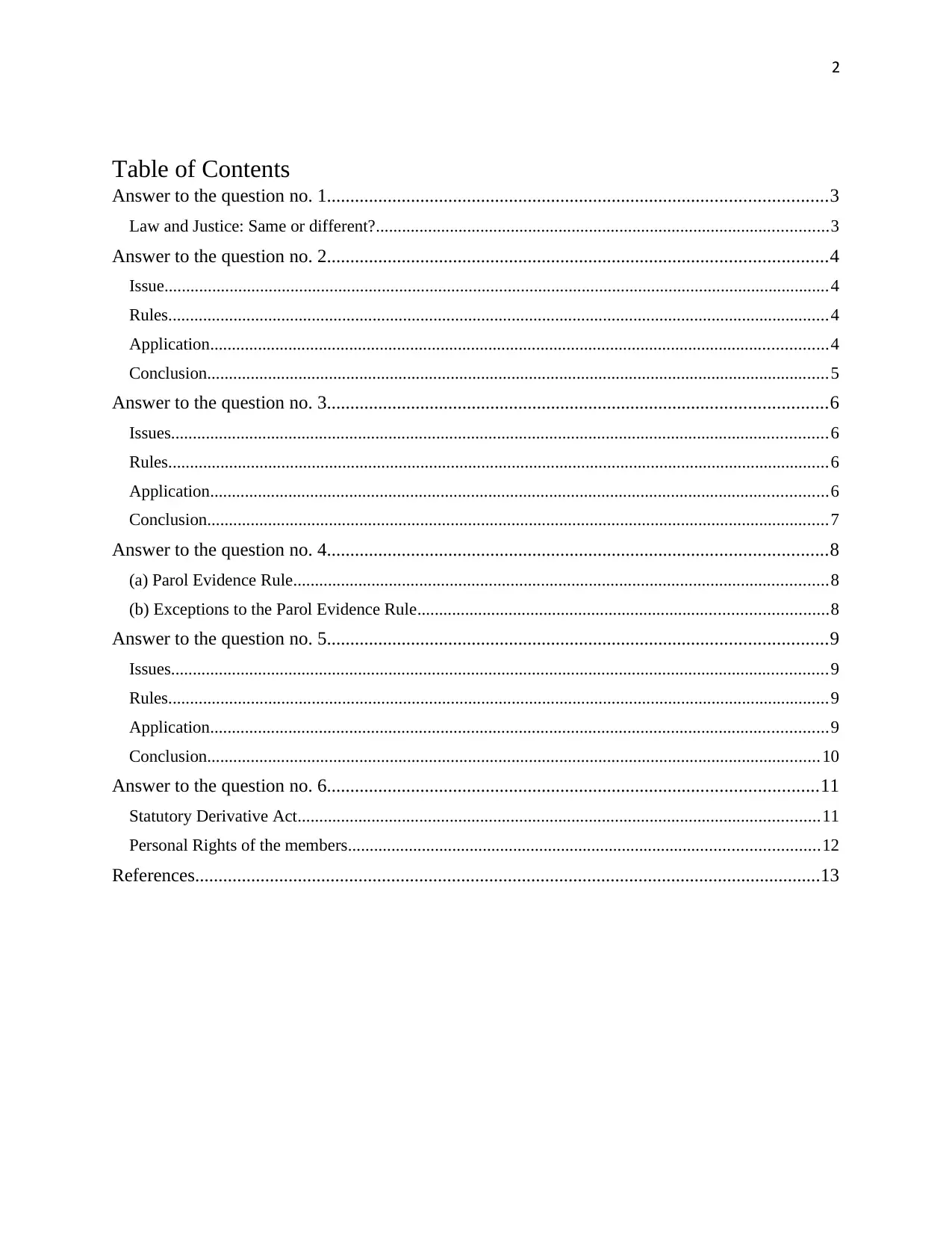
2
Table of Contents
Answer to the question no. 1...........................................................................................................3
Law and Justice: Same or different?........................................................................................................3
Answer to the question no. 2...........................................................................................................4
Issue.........................................................................................................................................................4
Rules........................................................................................................................................................4
Application..............................................................................................................................................4
Conclusion...............................................................................................................................................5
Answer to the question no. 3...........................................................................................................6
Issues.......................................................................................................................................................6
Rules........................................................................................................................................................6
Application..............................................................................................................................................6
Conclusion...............................................................................................................................................7
Answer to the question no. 4...........................................................................................................8
(a) Parol Evidence Rule...........................................................................................................................8
(b) Exceptions to the Parol Evidence Rule..............................................................................................8
Answer to the question no. 5...........................................................................................................9
Issues.......................................................................................................................................................9
Rules........................................................................................................................................................9
Application..............................................................................................................................................9
Conclusion.............................................................................................................................................10
Answer to the question no. 6.........................................................................................................11
Statutory Derivative Act........................................................................................................................11
Personal Rights of the members............................................................................................................12
References......................................................................................................................................13
Table of Contents
Answer to the question no. 1...........................................................................................................3
Law and Justice: Same or different?........................................................................................................3
Answer to the question no. 2...........................................................................................................4
Issue.........................................................................................................................................................4
Rules........................................................................................................................................................4
Application..............................................................................................................................................4
Conclusion...............................................................................................................................................5
Answer to the question no. 3...........................................................................................................6
Issues.......................................................................................................................................................6
Rules........................................................................................................................................................6
Application..............................................................................................................................................6
Conclusion...............................................................................................................................................7
Answer to the question no. 4...........................................................................................................8
(a) Parol Evidence Rule...........................................................................................................................8
(b) Exceptions to the Parol Evidence Rule..............................................................................................8
Answer to the question no. 5...........................................................................................................9
Issues.......................................................................................................................................................9
Rules........................................................................................................................................................9
Application..............................................................................................................................................9
Conclusion.............................................................................................................................................10
Answer to the question no. 6.........................................................................................................11
Statutory Derivative Act........................................................................................................................11
Personal Rights of the members............................................................................................................12
References......................................................................................................................................13
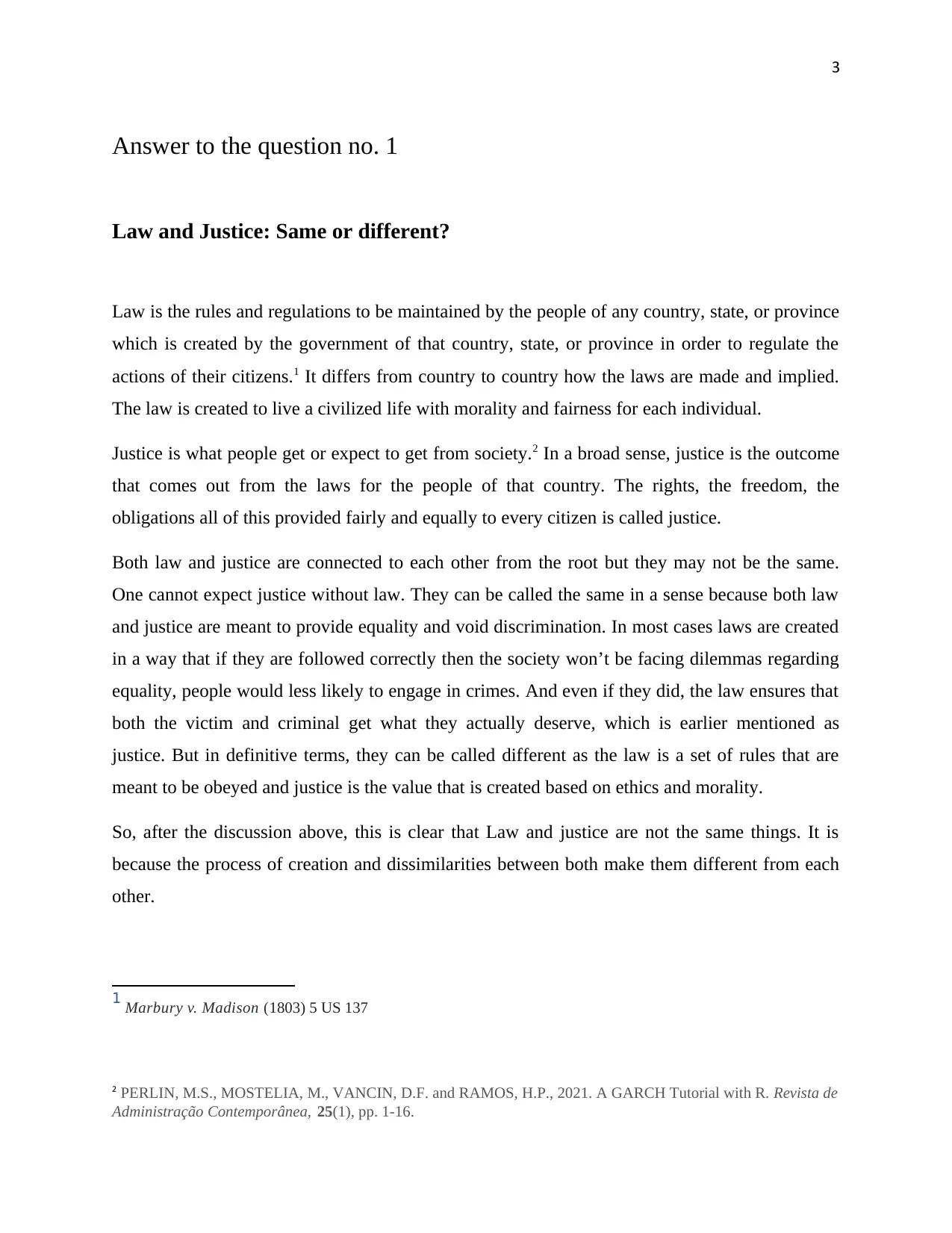
3
Answer to the question no. 1
Law and Justice: Same or different?
Law is the rules and regulations to be maintained by the people of any country, state, or province
which is created by the government of that country, state, or province in order to regulate the
actions of their citizens.1 It differs from country to country how the laws are made and implied.
The law is created to live a civilized life with morality and fairness for each individual.
Justice is what people get or expect to get from society.2 In a broad sense, justice is the outcome
that comes out from the laws for the people of that country. The rights, the freedom, the
obligations all of this provided fairly and equally to every citizen is called justice.
Both law and justice are connected to each other from the root but they may not be the same.
One cannot expect justice without law. They can be called the same in a sense because both law
and justice are meant to provide equality and void discrimination. In most cases laws are created
in a way that if they are followed correctly then the society won’t be facing dilemmas regarding
equality, people would less likely to engage in crimes. And even if they did, the law ensures that
both the victim and criminal get what they actually deserve, which is earlier mentioned as
justice. But in definitive terms, they can be called different as the law is a set of rules that are
meant to be obeyed and justice is the value that is created based on ethics and morality.
So, after the discussion above, this is clear that Law and justice are not the same things. It is
because the process of creation and dissimilarities between both make them different from each
other.
1 Marbury v. Madison (1803) 5 US 137
2 PERLIN, M.S., MOSTELIA, M., VANCIN, D.F. and RAMOS, H.P., 2021. A GARCH Tutorial with R. Revista de
Administração Contemporânea, 25(1), pp. 1-16.
Answer to the question no. 1
Law and Justice: Same or different?
Law is the rules and regulations to be maintained by the people of any country, state, or province
which is created by the government of that country, state, or province in order to regulate the
actions of their citizens.1 It differs from country to country how the laws are made and implied.
The law is created to live a civilized life with morality and fairness for each individual.
Justice is what people get or expect to get from society.2 In a broad sense, justice is the outcome
that comes out from the laws for the people of that country. The rights, the freedom, the
obligations all of this provided fairly and equally to every citizen is called justice.
Both law and justice are connected to each other from the root but they may not be the same.
One cannot expect justice without law. They can be called the same in a sense because both law
and justice are meant to provide equality and void discrimination. In most cases laws are created
in a way that if they are followed correctly then the society won’t be facing dilemmas regarding
equality, people would less likely to engage in crimes. And even if they did, the law ensures that
both the victim and criminal get what they actually deserve, which is earlier mentioned as
justice. But in definitive terms, they can be called different as the law is a set of rules that are
meant to be obeyed and justice is the value that is created based on ethics and morality.
So, after the discussion above, this is clear that Law and justice are not the same things. It is
because the process of creation and dissimilarities between both make them different from each
other.
1 Marbury v. Madison (1803) 5 US 137
2 PERLIN, M.S., MOSTELIA, M., VANCIN, D.F. and RAMOS, H.P., 2021. A GARCH Tutorial with R. Revista de
Administração Contemporânea, 25(1), pp. 1-16.
⊘ This is a preview!⊘
Do you want full access?
Subscribe today to unlock all pages.

Trusted by 1+ million students worldwide
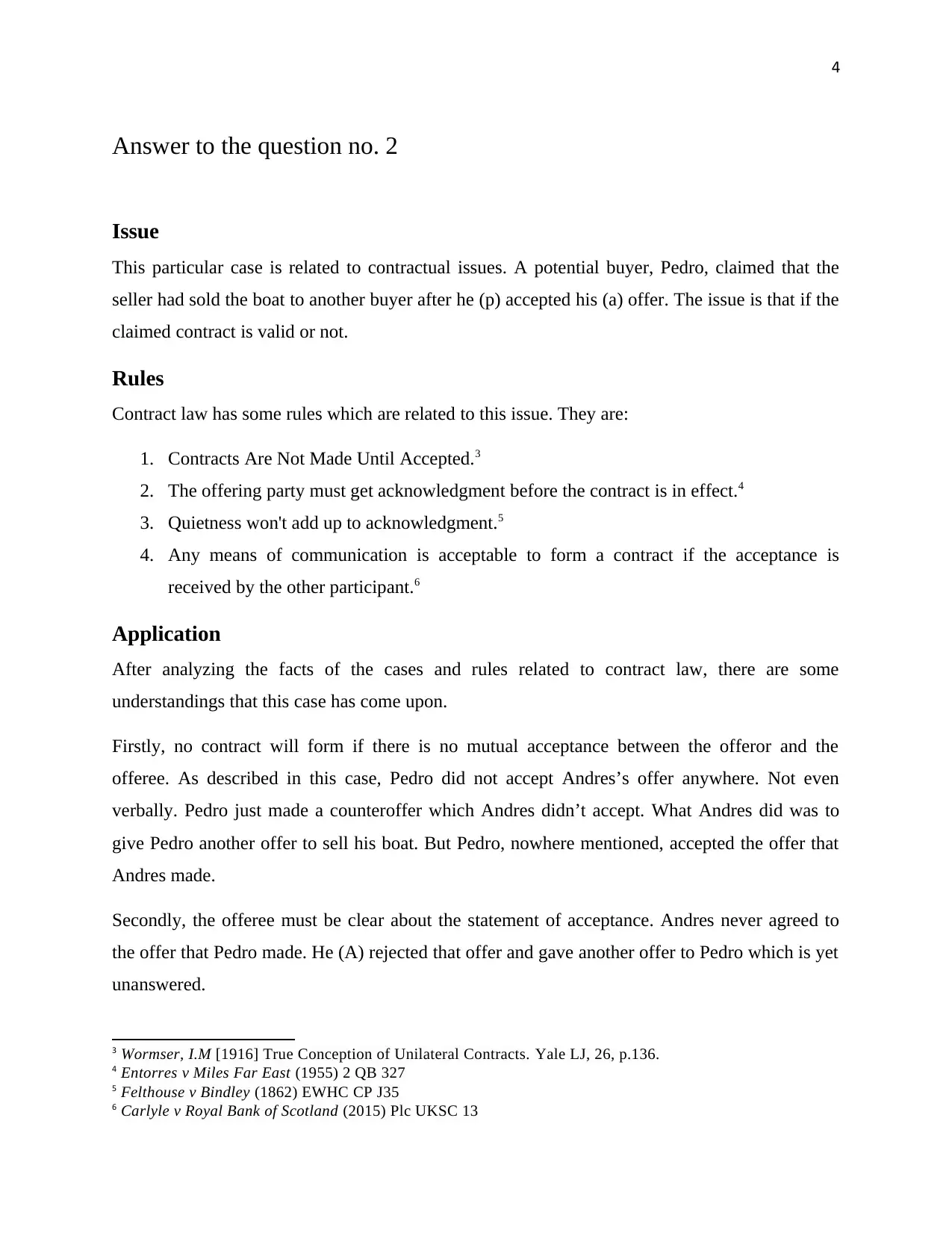
4
Answer to the question no. 2
Issue
This particular case is related to contractual issues. A potential buyer, Pedro, claimed that the
seller had sold the boat to another buyer after he (p) accepted his (a) offer. The issue is that if the
claimed contract is valid or not.
Rules
Contract law has some rules which are related to this issue. They are:
1. Contracts Are Not Made Until Accepted.3
2. The offering party must get acknowledgment before the contract is in effect.4
3. Quietness won't add up to acknowledgment.5
4. Any means of communication is acceptable to form a contract if the acceptance is
received by the other participant.6
Application
After analyzing the facts of the cases and rules related to contract law, there are some
understandings that this case has come upon.
Firstly, no contract will form if there is no mutual acceptance between the offeror and the
offeree. As described in this case, Pedro did not accept Andres’s offer anywhere. Not even
verbally. Pedro just made a counteroffer which Andres didn’t accept. What Andres did was to
give Pedro another offer to sell his boat. But Pedro, nowhere mentioned, accepted the offer that
Andres made.
Secondly, the offeree must be clear about the statement of acceptance. Andres never agreed to
the offer that Pedro made. He (A) rejected that offer and gave another offer to Pedro which is yet
unanswered.
3 Wormser, I.M [1916] True Conception of Unilateral Contracts. Yale LJ, 26, p.136.
4 Entorres v Miles Far East (1955) 2 QB 327
5 Felthouse v Bindley (1862) EWHC CP J35
6 Carlyle v Royal Bank of Scotland (2015) Plc UKSC 13
Answer to the question no. 2
Issue
This particular case is related to contractual issues. A potential buyer, Pedro, claimed that the
seller had sold the boat to another buyer after he (p) accepted his (a) offer. The issue is that if the
claimed contract is valid or not.
Rules
Contract law has some rules which are related to this issue. They are:
1. Contracts Are Not Made Until Accepted.3
2. The offering party must get acknowledgment before the contract is in effect.4
3. Quietness won't add up to acknowledgment.5
4. Any means of communication is acceptable to form a contract if the acceptance is
received by the other participant.6
Application
After analyzing the facts of the cases and rules related to contract law, there are some
understandings that this case has come upon.
Firstly, no contract will form if there is no mutual acceptance between the offeror and the
offeree. As described in this case, Pedro did not accept Andres’s offer anywhere. Not even
verbally. Pedro just made a counteroffer which Andres didn’t accept. What Andres did was to
give Pedro another offer to sell his boat. But Pedro, nowhere mentioned, accepted the offer that
Andres made.
Secondly, the offeree must be clear about the statement of acceptance. Andres never agreed to
the offer that Pedro made. He (A) rejected that offer and gave another offer to Pedro which is yet
unanswered.
3 Wormser, I.M [1916] True Conception of Unilateral Contracts. Yale LJ, 26, p.136.
4 Entorres v Miles Far East (1955) 2 QB 327
5 Felthouse v Bindley (1862) EWHC CP J35
6 Carlyle v Royal Bank of Scotland (2015) Plc UKSC 13
Paraphrase This Document
Need a fresh take? Get an instant paraphrase of this document with our AI Paraphraser
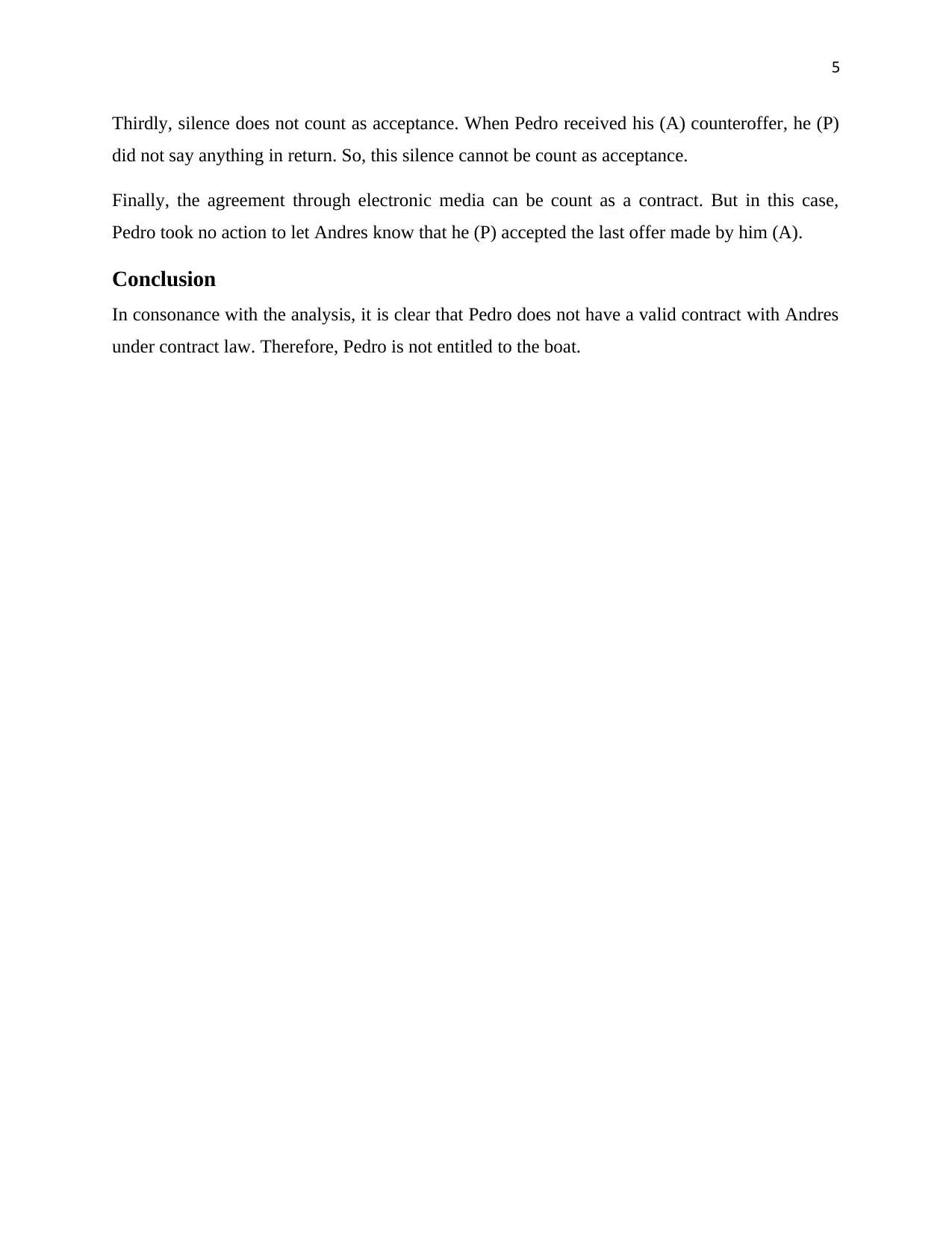
5
Thirdly, silence does not count as acceptance. When Pedro received his (A) counteroffer, he (P)
did not say anything in return. So, this silence cannot be count as acceptance.
Finally, the agreement through electronic media can be count as a contract. But in this case,
Pedro took no action to let Andres know that he (P) accepted the last offer made by him (A).
Conclusion
In consonance with the analysis, it is clear that Pedro does not have a valid contract with Andres
under contract law. Therefore, Pedro is not entitled to the boat.
Thirdly, silence does not count as acceptance. When Pedro received his (A) counteroffer, he (P)
did not say anything in return. So, this silence cannot be count as acceptance.
Finally, the agreement through electronic media can be count as a contract. But in this case,
Pedro took no action to let Andres know that he (P) accepted the last offer made by him (A).
Conclusion
In consonance with the analysis, it is clear that Pedro does not have a valid contract with Andres
under contract law. Therefore, Pedro is not entitled to the boat.
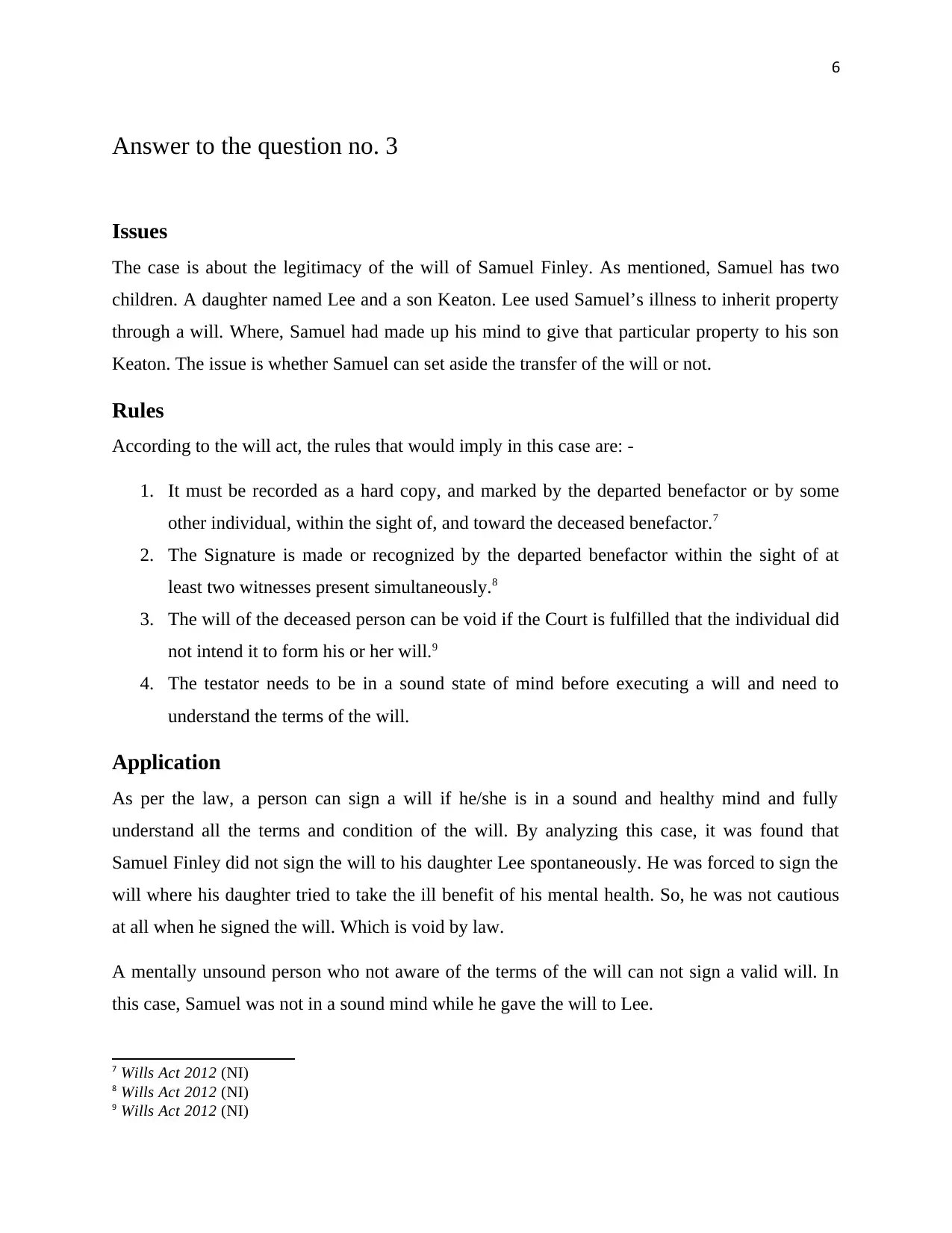
6
Answer to the question no. 3
Issues
The case is about the legitimacy of the will of Samuel Finley. As mentioned, Samuel has two
children. A daughter named Lee and a son Keaton. Lee used Samuel’s illness to inherit property
through a will. Where, Samuel had made up his mind to give that particular property to his son
Keaton. The issue is whether Samuel can set aside the transfer of the will or not.
Rules
According to the will act, the rules that would imply in this case are: -
1. It must be recorded as a hard copy, and marked by the departed benefactor or by some
other individual, within the sight of, and toward the deceased benefactor.7
2. The Signature is made or recognized by the departed benefactor within the sight of at
least two witnesses present simultaneously.8
3. The will of the deceased person can be void if the Court is fulfilled that the individual did
not intend it to form his or her will.9
4. The testator needs to be in a sound state of mind before executing a will and need to
understand the terms of the will.
Application
As per the law, a person can sign a will if he/she is in a sound and healthy mind and fully
understand all the terms and condition of the will. By analyzing this case, it was found that
Samuel Finley did not sign the will to his daughter Lee spontaneously. He was forced to sign the
will where his daughter tried to take the ill benefit of his mental health. So, he was not cautious
at all when he signed the will. Which is void by law.
A mentally unsound person who not aware of the terms of the will can not sign a valid will. In
this case, Samuel was not in a sound mind while he gave the will to Lee.
7 Wills Act 2012 (NI)
8 Wills Act 2012 (NI)
9 Wills Act 2012 (NI)
Answer to the question no. 3
Issues
The case is about the legitimacy of the will of Samuel Finley. As mentioned, Samuel has two
children. A daughter named Lee and a son Keaton. Lee used Samuel’s illness to inherit property
through a will. Where, Samuel had made up his mind to give that particular property to his son
Keaton. The issue is whether Samuel can set aside the transfer of the will or not.
Rules
According to the will act, the rules that would imply in this case are: -
1. It must be recorded as a hard copy, and marked by the departed benefactor or by some
other individual, within the sight of, and toward the deceased benefactor.7
2. The Signature is made or recognized by the departed benefactor within the sight of at
least two witnesses present simultaneously.8
3. The will of the deceased person can be void if the Court is fulfilled that the individual did
not intend it to form his or her will.9
4. The testator needs to be in a sound state of mind before executing a will and need to
understand the terms of the will.
Application
As per the law, a person can sign a will if he/she is in a sound and healthy mind and fully
understand all the terms and condition of the will. By analyzing this case, it was found that
Samuel Finley did not sign the will to his daughter Lee spontaneously. He was forced to sign the
will where his daughter tried to take the ill benefit of his mental health. So, he was not cautious
at all when he signed the will. Which is void by law.
A mentally unsound person who not aware of the terms of the will can not sign a valid will. In
this case, Samuel was not in a sound mind while he gave the will to Lee.
7 Wills Act 2012 (NI)
8 Wills Act 2012 (NI)
9 Wills Act 2012 (NI)
⊘ This is a preview!⊘
Do you want full access?
Subscribe today to unlock all pages.

Trusted by 1+ million students worldwide
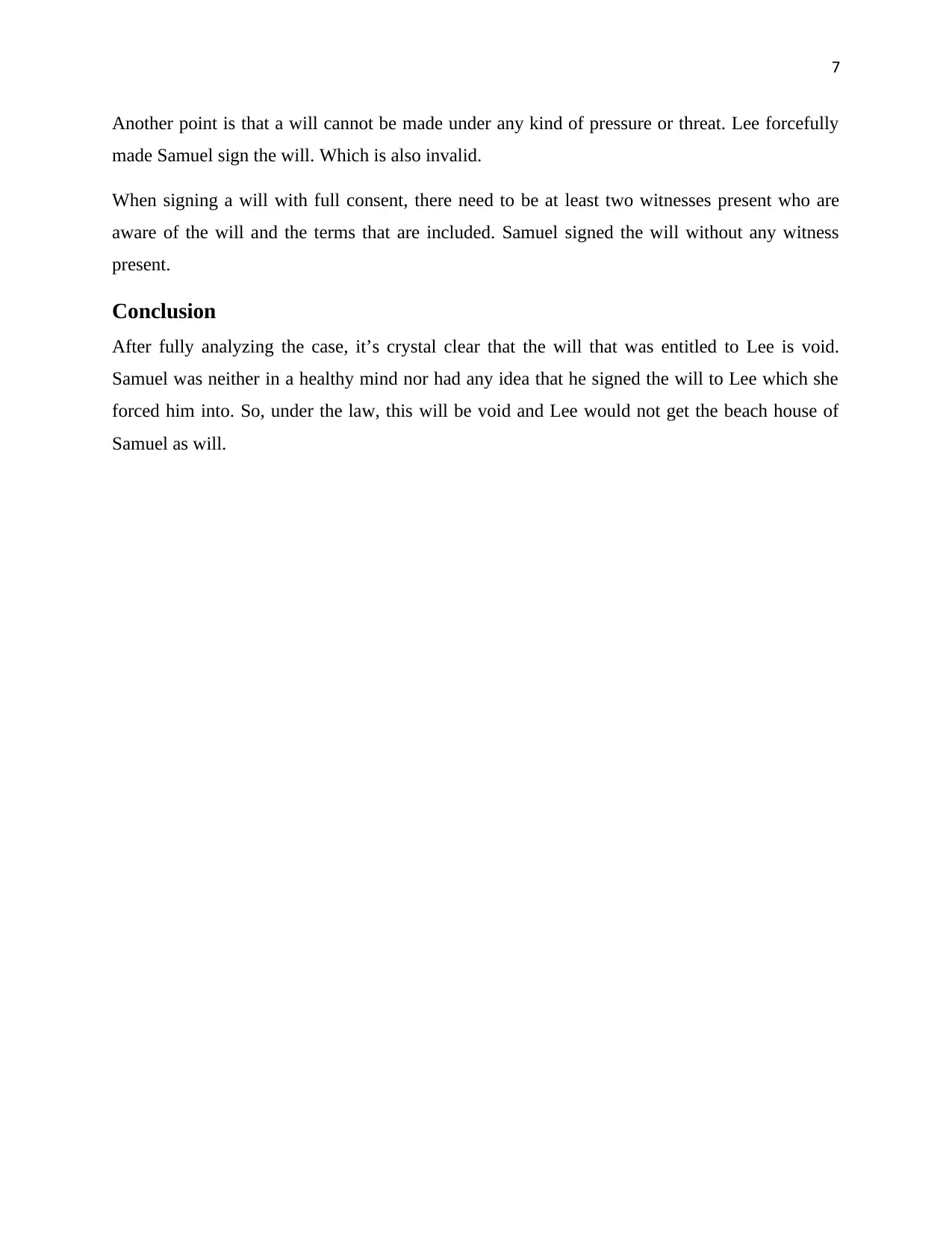
7
Another point is that a will cannot be made under any kind of pressure or threat. Lee forcefully
made Samuel sign the will. Which is also invalid.
When signing a will with full consent, there need to be at least two witnesses present who are
aware of the will and the terms that are included. Samuel signed the will without any witness
present.
Conclusion
After fully analyzing the case, it’s crystal clear that the will that was entitled to Lee is void.
Samuel was neither in a healthy mind nor had any idea that he signed the will to Lee which she
forced him into. So, under the law, this will be void and Lee would not get the beach house of
Samuel as will.
Another point is that a will cannot be made under any kind of pressure or threat. Lee forcefully
made Samuel sign the will. Which is also invalid.
When signing a will with full consent, there need to be at least two witnesses present who are
aware of the will and the terms that are included. Samuel signed the will without any witness
present.
Conclusion
After fully analyzing the case, it’s crystal clear that the will that was entitled to Lee is void.
Samuel was neither in a healthy mind nor had any idea that he signed the will to Lee which she
forced him into. So, under the law, this will be void and Lee would not get the beach house of
Samuel as will.
Paraphrase This Document
Need a fresh take? Get an instant paraphrase of this document with our AI Paraphraser
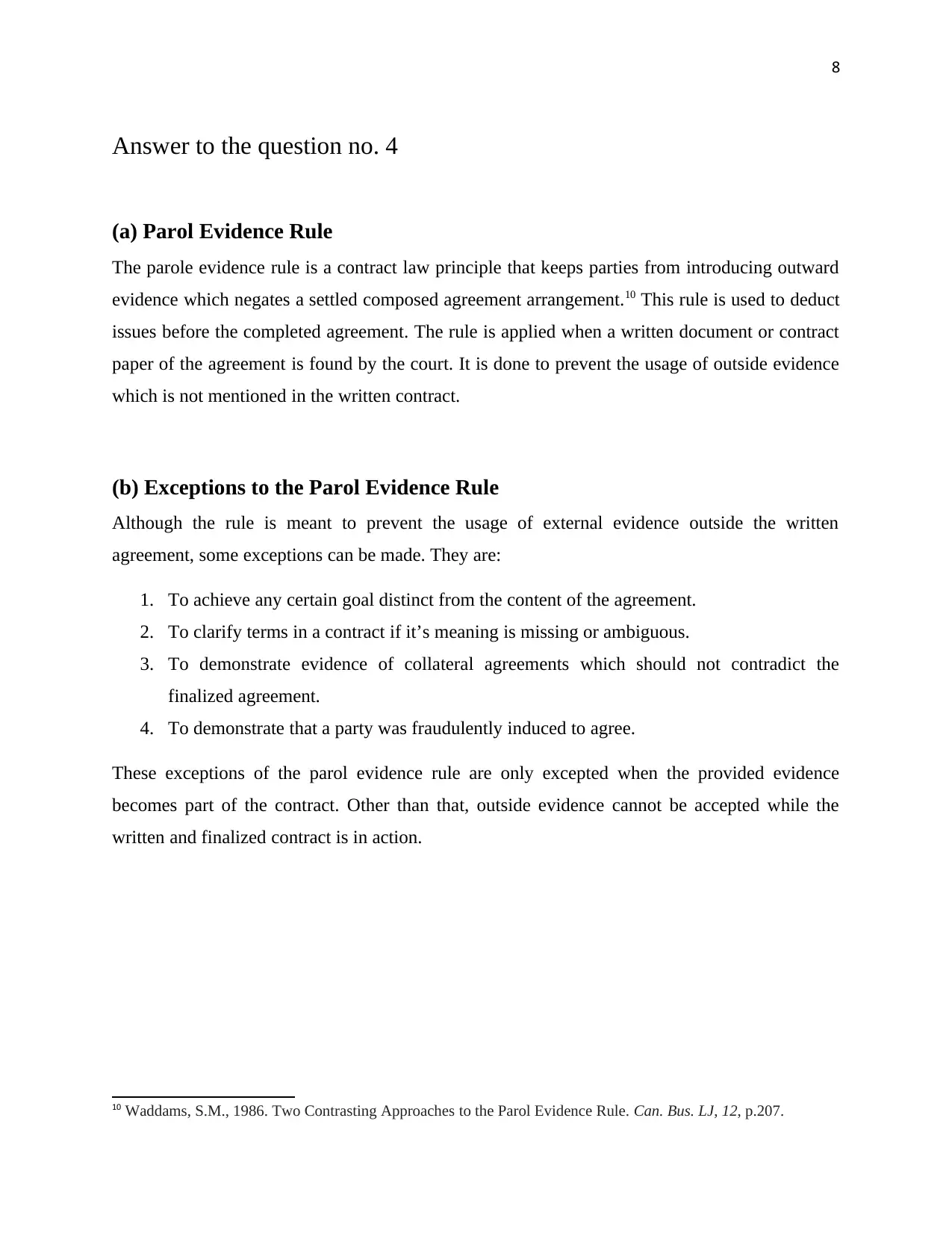
8
Answer to the question no. 4
(a) Parol Evidence Rule
The parole evidence rule is a contract law principle that keeps parties from introducing outward
evidence which negates a settled composed agreement arrangement.10 This rule is used to deduct
issues before the completed agreement. The rule is applied when a written document or contract
paper of the agreement is found by the court. It is done to prevent the usage of outside evidence
which is not mentioned in the written contract.
(b) Exceptions to the Parol Evidence Rule
Although the rule is meant to prevent the usage of external evidence outside the written
agreement, some exceptions can be made. They are:
1. To achieve any certain goal distinct from the content of the agreement.
2. To clarify terms in a contract if it’s meaning is missing or ambiguous.
3. To demonstrate evidence of collateral agreements which should not contradict the
finalized agreement.
4. To demonstrate that a party was fraudulently induced to agree.
These exceptions of the parol evidence rule are only excepted when the provided evidence
becomes part of the contract. Other than that, outside evidence cannot be accepted while the
written and finalized contract is in action.
10 Waddams, S.M., 1986. Two Contrasting Approaches to the Parol Evidence Rule. Can. Bus. LJ, 12, p.207.
Answer to the question no. 4
(a) Parol Evidence Rule
The parole evidence rule is a contract law principle that keeps parties from introducing outward
evidence which negates a settled composed agreement arrangement.10 This rule is used to deduct
issues before the completed agreement. The rule is applied when a written document or contract
paper of the agreement is found by the court. It is done to prevent the usage of outside evidence
which is not mentioned in the written contract.
(b) Exceptions to the Parol Evidence Rule
Although the rule is meant to prevent the usage of external evidence outside the written
agreement, some exceptions can be made. They are:
1. To achieve any certain goal distinct from the content of the agreement.
2. To clarify terms in a contract if it’s meaning is missing or ambiguous.
3. To demonstrate evidence of collateral agreements which should not contradict the
finalized agreement.
4. To demonstrate that a party was fraudulently induced to agree.
These exceptions of the parol evidence rule are only excepted when the provided evidence
becomes part of the contract. Other than that, outside evidence cannot be accepted while the
written and finalized contract is in action.
10 Waddams, S.M., 1986. Two Contrasting Approaches to the Parol Evidence Rule. Can. Bus. LJ, 12, p.207.
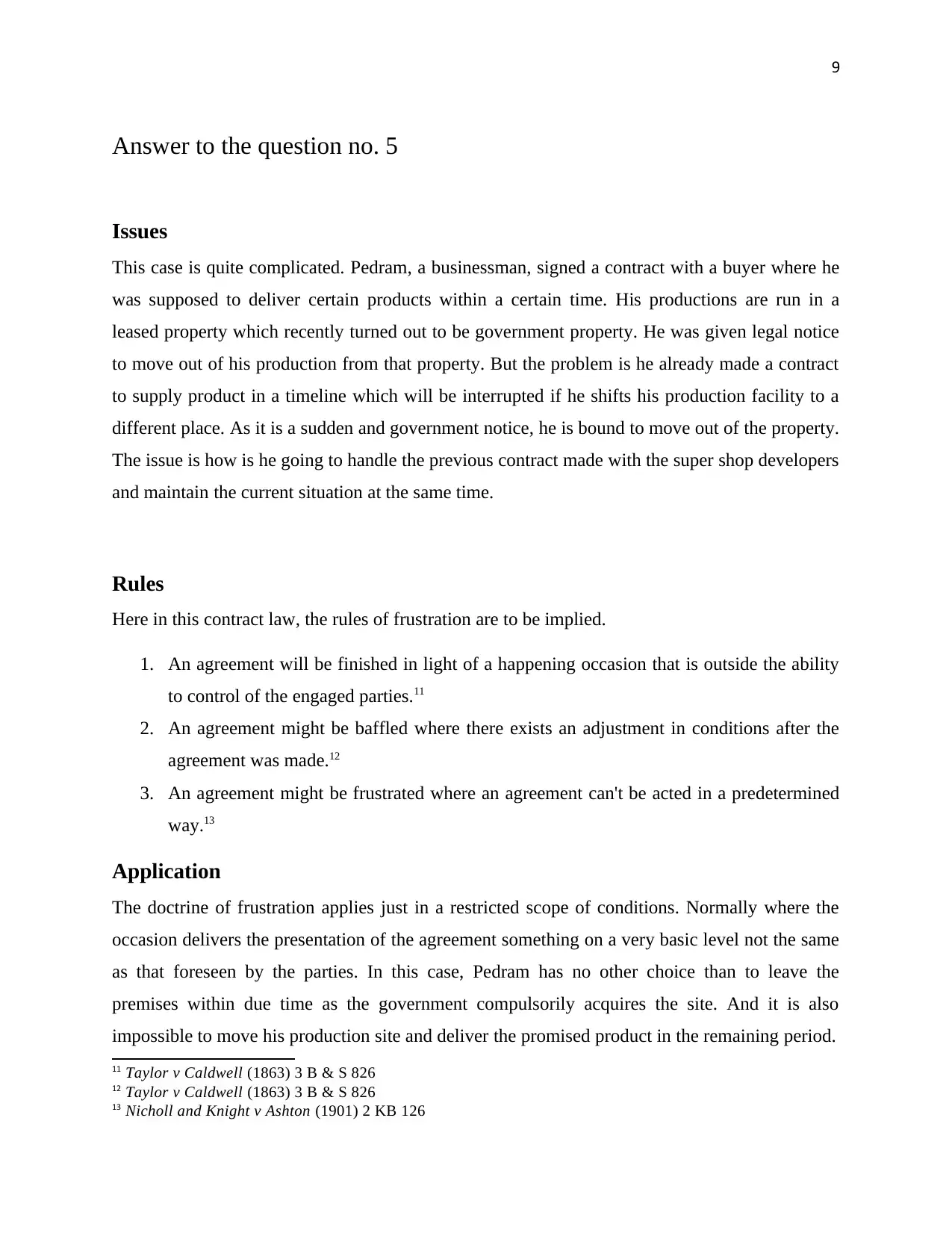
9
Answer to the question no. 5
Issues
This case is quite complicated. Pedram, a businessman, signed a contract with a buyer where he
was supposed to deliver certain products within a certain time. His productions are run in a
leased property which recently turned out to be government property. He was given legal notice
to move out of his production from that property. But the problem is he already made a contract
to supply product in a timeline which will be interrupted if he shifts his production facility to a
different place. As it is a sudden and government notice, he is bound to move out of the property.
The issue is how is he going to handle the previous contract made with the super shop developers
and maintain the current situation at the same time.
Rules
Here in this contract law, the rules of frustration are to be implied.
1. An agreement will be finished in light of a happening occasion that is outside the ability
to control of the engaged parties.11
2. An agreement might be baffled where there exists an adjustment in conditions after the
agreement was made.12
3. An agreement might be frustrated where an agreement can't be acted in a predetermined
way.13
Application
The doctrine of frustration applies just in a restricted scope of conditions. Normally where the
occasion delivers the presentation of the agreement something on a very basic level not the same
as that foreseen by the parties. In this case, Pedram has no other choice than to leave the
premises within due time as the government compulsorily acquires the site. And it is also
impossible to move his production site and deliver the promised product in the remaining period.
11 Taylor v Caldwell (1863) 3 B & S 826
12 Taylor v Caldwell (1863) 3 B & S 826
13 Nicholl and Knight v Ashton (1901) 2 KB 126
Answer to the question no. 5
Issues
This case is quite complicated. Pedram, a businessman, signed a contract with a buyer where he
was supposed to deliver certain products within a certain time. His productions are run in a
leased property which recently turned out to be government property. He was given legal notice
to move out of his production from that property. But the problem is he already made a contract
to supply product in a timeline which will be interrupted if he shifts his production facility to a
different place. As it is a sudden and government notice, he is bound to move out of the property.
The issue is how is he going to handle the previous contract made with the super shop developers
and maintain the current situation at the same time.
Rules
Here in this contract law, the rules of frustration are to be implied.
1. An agreement will be finished in light of a happening occasion that is outside the ability
to control of the engaged parties.11
2. An agreement might be baffled where there exists an adjustment in conditions after the
agreement was made.12
3. An agreement might be frustrated where an agreement can't be acted in a predetermined
way.13
Application
The doctrine of frustration applies just in a restricted scope of conditions. Normally where the
occasion delivers the presentation of the agreement something on a very basic level not the same
as that foreseen by the parties. In this case, Pedram has no other choice than to leave the
premises within due time as the government compulsorily acquires the site. And it is also
impossible to move his production site and deliver the promised product in the remaining period.
11 Taylor v Caldwell (1863) 3 B & S 826
12 Taylor v Caldwell (1863) 3 B & S 826
13 Nicholl and Knight v Ashton (1901) 2 KB 126
⊘ This is a preview!⊘
Do you want full access?
Subscribe today to unlock all pages.

Trusted by 1+ million students worldwide
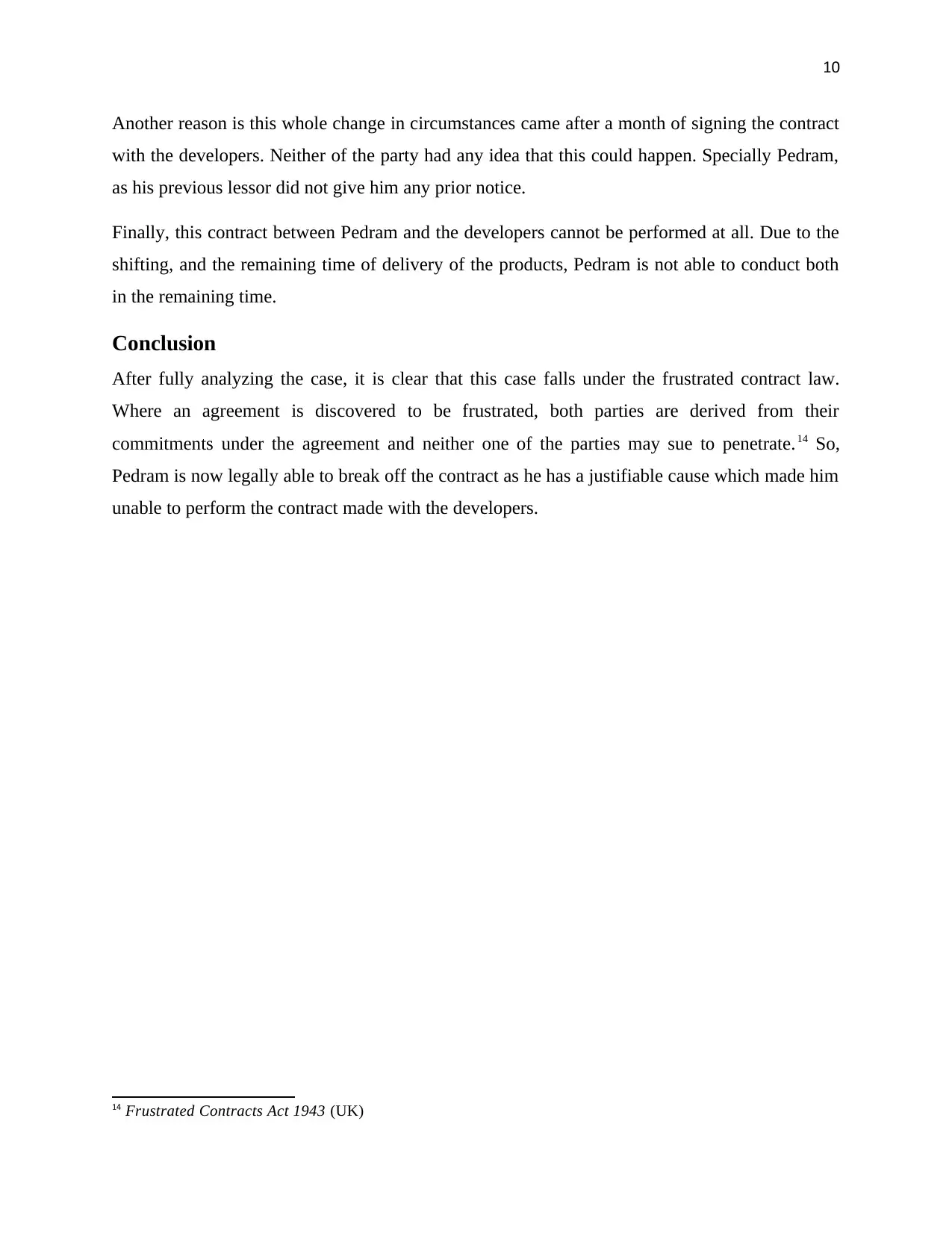
10
Another reason is this whole change in circumstances came after a month of signing the contract
with the developers. Neither of the party had any idea that this could happen. Specially Pedram,
as his previous lessor did not give him any prior notice.
Finally, this contract between Pedram and the developers cannot be performed at all. Due to the
shifting, and the remaining time of delivery of the products, Pedram is not able to conduct both
in the remaining time.
Conclusion
After fully analyzing the case, it is clear that this case falls under the frustrated contract law.
Where an agreement is discovered to be frustrated, both parties are derived from their
commitments under the agreement and neither one of the parties may sue to penetrate.14 So,
Pedram is now legally able to break off the contract as he has a justifiable cause which made him
unable to perform the contract made with the developers.
14 Frustrated Contracts Act 1943 (UK)
Another reason is this whole change in circumstances came after a month of signing the contract
with the developers. Neither of the party had any idea that this could happen. Specially Pedram,
as his previous lessor did not give him any prior notice.
Finally, this contract between Pedram and the developers cannot be performed at all. Due to the
shifting, and the remaining time of delivery of the products, Pedram is not able to conduct both
in the remaining time.
Conclusion
After fully analyzing the case, it is clear that this case falls under the frustrated contract law.
Where an agreement is discovered to be frustrated, both parties are derived from their
commitments under the agreement and neither one of the parties may sue to penetrate.14 So,
Pedram is now legally able to break off the contract as he has a justifiable cause which made him
unable to perform the contract made with the developers.
14 Frustrated Contracts Act 1943 (UK)
Paraphrase This Document
Need a fresh take? Get an instant paraphrase of this document with our AI Paraphraser
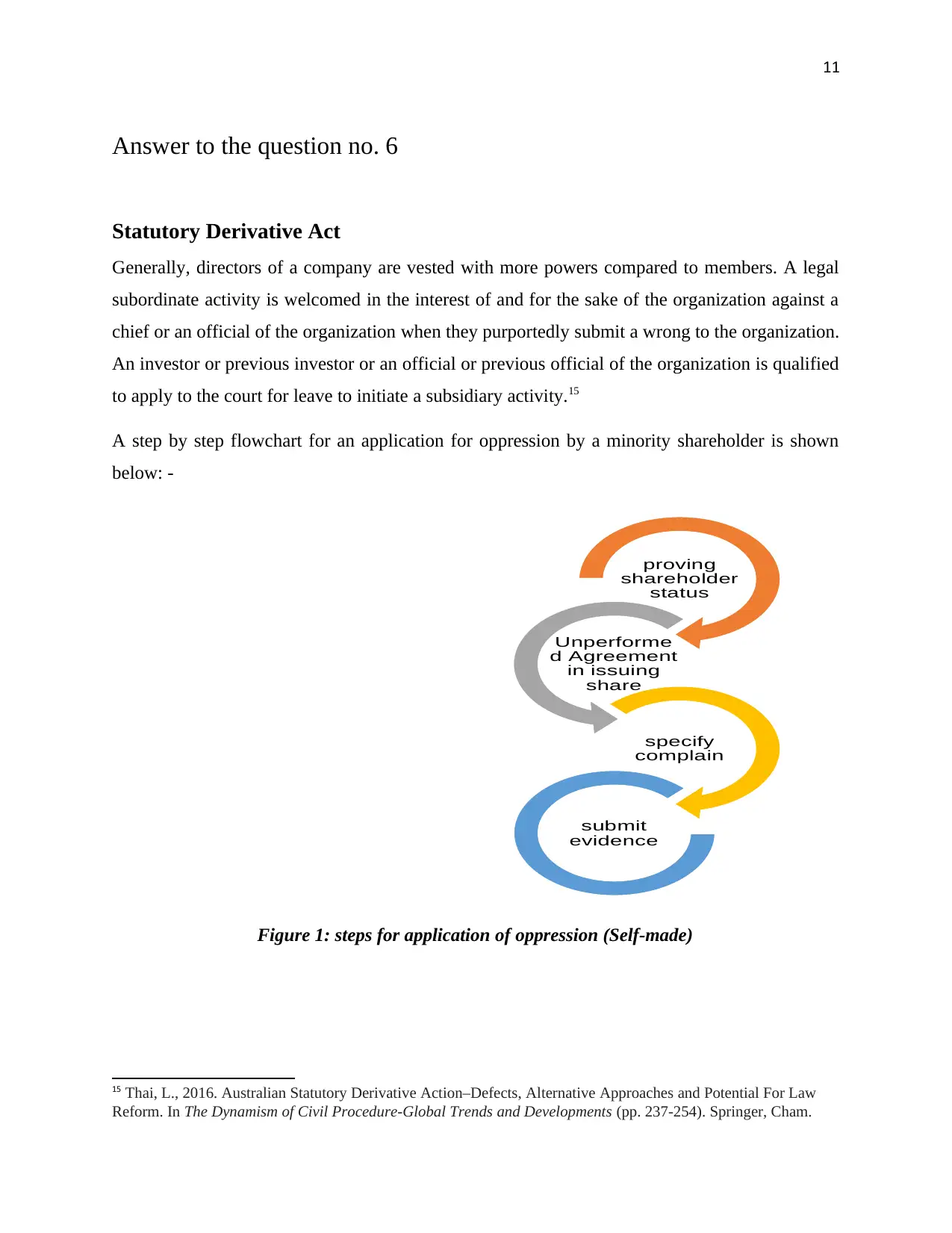
11
Answer to the question no. 6
Statutory Derivative Act
Generally, directors of a company are vested with more powers compared to members. A legal
subordinate activity is welcomed in the interest of and for the sake of the organization against a
chief or an official of the organization when they purportedly submit a wrong to the organization.
An investor or previous investor or an official or previous official of the organization is qualified
to apply to the court for leave to initiate a subsidiary activity.15
A step by step flowchart for an application for oppression by a minority shareholder is shown
below: -
Figure 1: steps for application of oppression (Self-made)
15 Thai, L., 2016. Australian Statutory Derivative Action–Defects, Alternative Approaches and Potential For Law
Reform. In The Dynamism of Civil Procedure-Global Trends and Developments (pp. 237-254). Springer, Cham.
proving
shareholder
status
Unperforme
d Agreement
in issuing
share
specify
complain
submit
evidence
Answer to the question no. 6
Statutory Derivative Act
Generally, directors of a company are vested with more powers compared to members. A legal
subordinate activity is welcomed in the interest of and for the sake of the organization against a
chief or an official of the organization when they purportedly submit a wrong to the organization.
An investor or previous investor or an official or previous official of the organization is qualified
to apply to the court for leave to initiate a subsidiary activity.15
A step by step flowchart for an application for oppression by a minority shareholder is shown
below: -
Figure 1: steps for application of oppression (Self-made)
15 Thai, L., 2016. Australian Statutory Derivative Action–Defects, Alternative Approaches and Potential For Law
Reform. In The Dynamism of Civil Procedure-Global Trends and Developments (pp. 237-254). Springer, Cham.
proving
shareholder
status
Unperforme
d Agreement
in issuing
share
specify
complain
submit
evidence
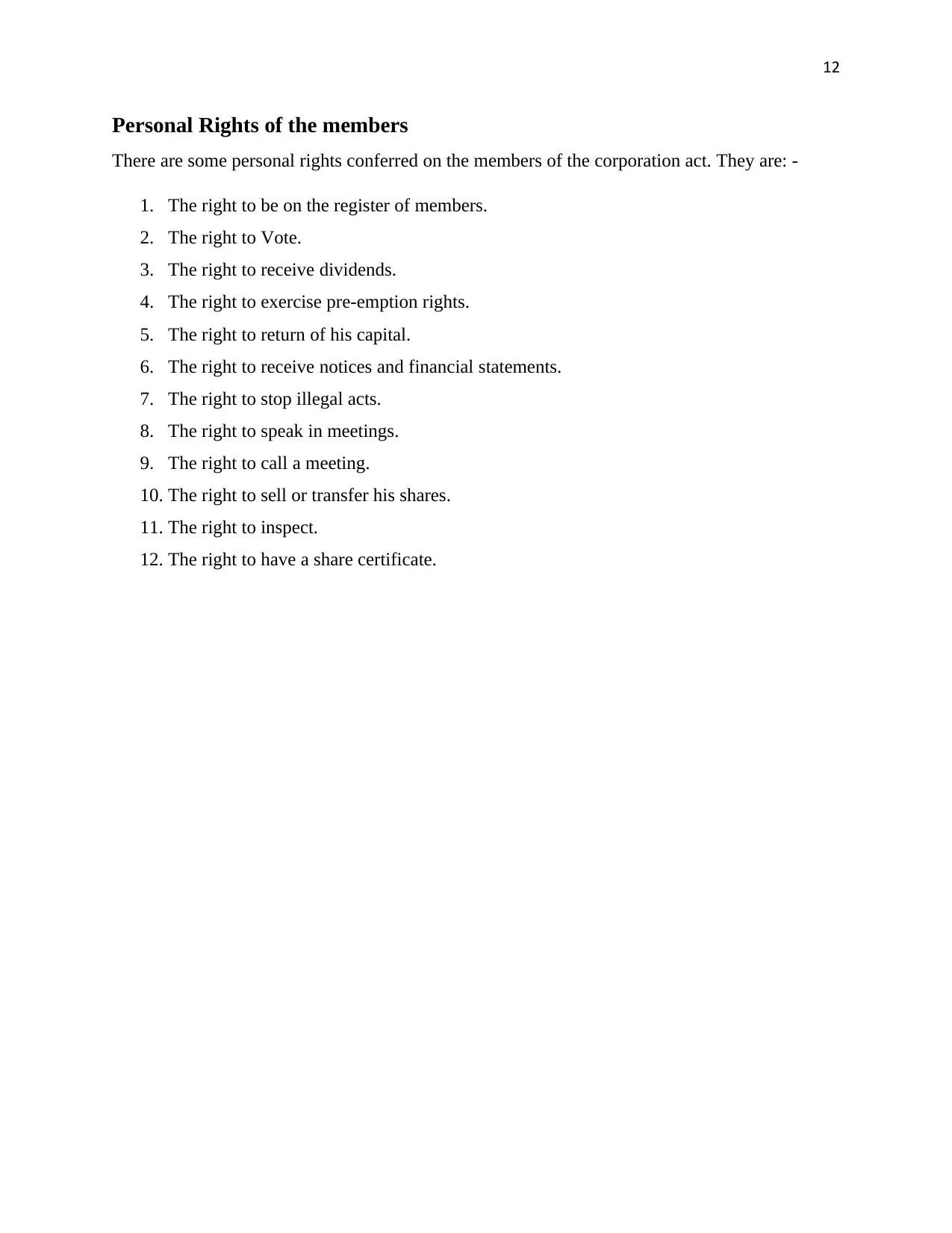
12
Personal Rights of the members
There are some personal rights conferred on the members of the corporation act. They are: -
1. The right to be on the register of members.
2. The right to Vote.
3. The right to receive dividends.
4. The right to exercise pre-emption rights.
5. The right to return of his capital.
6. The right to receive notices and financial statements.
7. The right to stop illegal acts.
8. The right to speak in meetings.
9. The right to call a meeting.
10. The right to sell or transfer his shares.
11. The right to inspect.
12. The right to have a share certificate.
Personal Rights of the members
There are some personal rights conferred on the members of the corporation act. They are: -
1. The right to be on the register of members.
2. The right to Vote.
3. The right to receive dividends.
4. The right to exercise pre-emption rights.
5. The right to return of his capital.
6. The right to receive notices and financial statements.
7. The right to stop illegal acts.
8. The right to speak in meetings.
9. The right to call a meeting.
10. The right to sell or transfer his shares.
11. The right to inspect.
12. The right to have a share certificate.
⊘ This is a preview!⊘
Do you want full access?
Subscribe today to unlock all pages.

Trusted by 1+ million students worldwide
1 out of 13
Related Documents
Your All-in-One AI-Powered Toolkit for Academic Success.
+13062052269
info@desklib.com
Available 24*7 on WhatsApp / Email
![[object Object]](/_next/static/media/star-bottom.7253800d.svg)
Unlock your academic potential
Copyright © 2020–2025 A2Z Services. All Rights Reserved. Developed and managed by ZUCOL.





